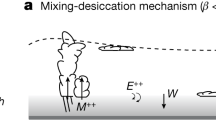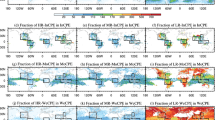Abstract
An important aspect in the study of cumulonimbus convection is the identification of situations that lead to intense rainfall. We examine here one such situation in which two initially separate clouds interact and merge. The process is found to depend on the variation of wind with height, the relative stage of development of the two clouds and their initial separation. A numerical simulation is described in which merging is shown to increase the total surface precipitation by a factor of four.
This is a preview of subscription content, access via your institution
Access options
Subscribe to this journal
Receive 51 print issues and online access
$199.00 per year
only $3.90 per issue
Buy this article
- Purchase on SpringerLink
- Instant access to full article PDF
Prices may be subject to local taxes which are calculated during checkout
Similar content being viewed by others
References
Simpson, J., Westcott, N. E., Clerman, R. J. & Pielke, R. A. Arch. Met. Geophys. Bioklim. A29, 1–40 (1980).
Barrett, E. C. Proc. int. Training Course, Rome, 97–103 (1980).
Orville, H. D., Kuo, Y-H., Farley, R. D. & Hwang, C. S. J. Rech. atmos. 14, 499–516 (1980).
Browning, K. A. Met. Mag. 108, 161–184 (1979).
Bennetts, D. A. & Bader, M. J. in Cloud Dynamics (Reidel, Dordrecht, in the press).
Bennetts, D. A. & Rawlins, F. Q. Jl R. met. Soc. 107, 477–502 (1981).
Hill, F. F., Browning, K. A. & Bader, M. J. Q. Jl R. met. Soc. 107, 643–670 (1981).
Author information
Authors and Affiliations
Rights and permissions
About this article
Cite this article
Bennetts, D., Bader, M. & Marles, R. Convective cloud merging and its effect on rainfall. Nature 300, 42–45 (1982). https://doi.org/10.1038/300042a0
Received:
Accepted:
Issue date:
DOI: https://doi.org/10.1038/300042a0



